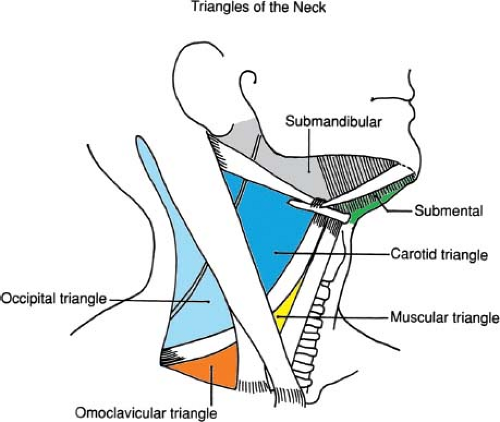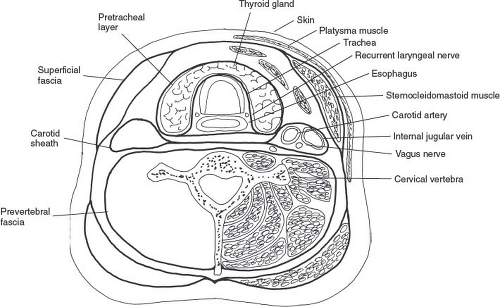Introduction
General surgical procedures involving the neck can be divided into those that are performed through a midline approach and those that are performed through a lateral incision. Accordingly, the anatomy of the neck is explored in this section first through structures approached through the midline (trachea, thyroid, parathyroid) and then through structures approached laterally (lymph nodes, major vessels, cervical esophagus).
Important structures approached from the midline of the neck include the thyroid and parathyroid glands and the trachea. Although the esophagus is a midline structure, it is often approached laterally because it lies deep to the trachea. The anatomy of the neck is separated by multiple fascial planes and commonly oriented by “triangle” groupings. Understanding these boundaries is essential to good surgical technique in the neck. For simplicity, visualize the multiple fascial layers as a set of “tubes within tubes” (Fig. 1).
After incising through skin and subcutaneous fat through the midline, the platysma muscle is exposed. This thin muscular layer is innervated by a branch of facial nerve, cranial nerve VII. The first encountered cervical fascial layer—forming the outer tube—invests all cervical structures and is just deep to the platysma. This layer, called the deep cervical fascia, splits to encompass the sternocleidomastoid muscle, the trapezius muscle, the corresponding spinal accessory nerve (cranial nerve XI), and the paired strap muscles (sternothyroid, sternohyoid, thyrohyoid, and omohyoid). This fascial layer attaches posteriorly to the ligamentum nuchae, which is the supraspinous ligament. At the root of the neck, the fascia splits to attach to both the anterior and posterior surfaces of the manubrium. The intervening suprasternal space (of Burns) contains the lower portion of the anterior jugular veins and their connecting branch, the jugular venous arch.
 Figure 2 Triangles of the neck as defined by muscle boundaries
Stay updated, free articles. Join our Telegram channel
Full access? Get Clinical Tree
 Get Clinical Tree app for offline access
Get Clinical Tree app for offline access

|
